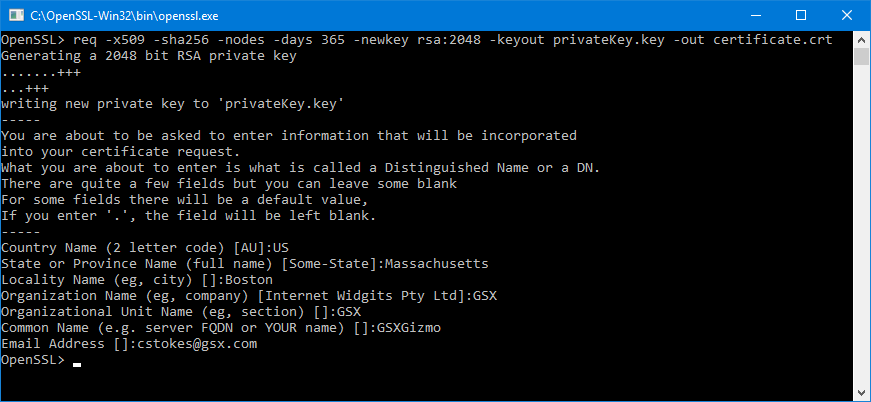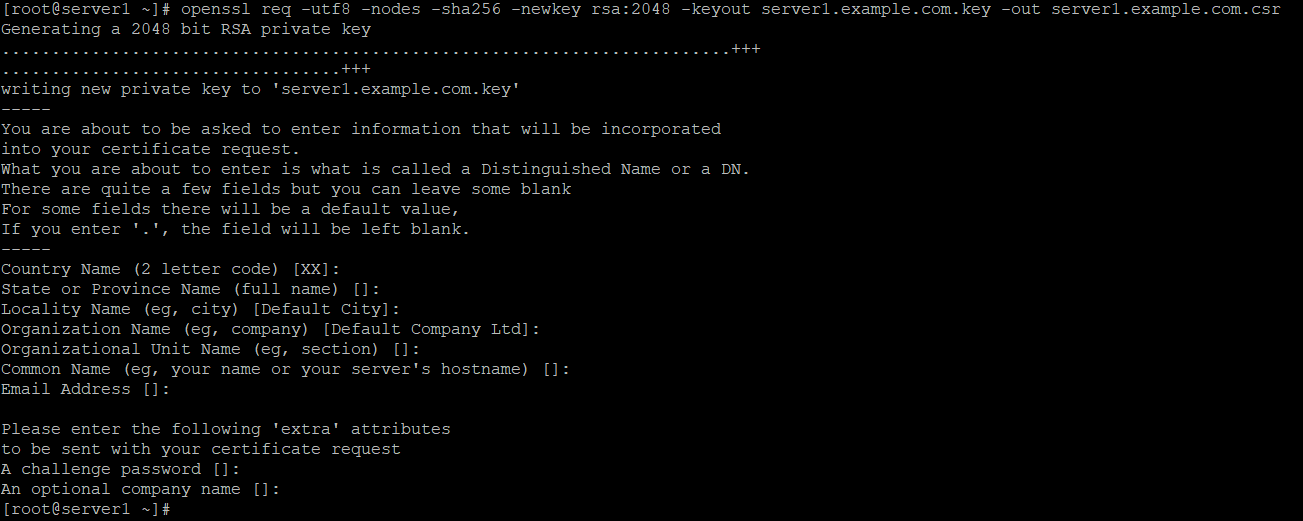Openssl Generate Rsa Key And Certificate
- To generate private (d,n) key using openssl you can use the following command: openssl genrsa -out private.pem 1024 To generate public (e,n) key from the private key using openssl you can use the following command: openssl rsa -in private.pem -out public.pem -pubout.
- OpenSSL – How to convert SSL Certificates to various formats – PEM CRT CER PFX P12 & more How to use the OpenSSL tool to convert a SSL certificate and private key on various formats (PEM, CRT, CER, PFX, P12, P7B, P7C extensions & more) on Windows and Linux platforms.
Generate CSR - OpenSSL
Sep 11, 2018 The first thing to do would be to generate a 2048-bit RSA key pair locally. This pair will contain both your private and public key. You can use Java key tool or some other tool, but we will be working with OpenSSL. To generate a public and private key with a certificate signing request (CSR), run the following OpenSSL command. To generate RSA private key. Req -new -x509 -days 3650 -key ca/ca.key -out ca/ca.cer To create self-signed cretificate CA. Genrsa -des3 -out key.key 4096 To create RSA private key for web certificate. Req -new -key key.key -out cerreq.csr To create CSR. Ca -policy policyanything -cert ca/ca.cer -in cerreq.csr -keyfile ca/ca.key -days 365 -out. Apr 12, 2020 Step 6: Create your own Root CA Certificate. OpenSSL create certificate chain requires Root and Intermediate Certificate. In this step you’ll take the place of VeriSign, Thawte, etc. Use the Root CA key cakey.pem to create a Root CA certificate cacert.pem; Give the root certificate a long expiry date. How to Generate a Self-Signed Certificate and Private Key using OpenSSL Generating a private key and self-signed certificate can be accomplished in a few simple steps using OpenSSL. We provide here detailed instructions on how to create a private key and self-signed certificate valid for 365 days.
Introduction
This article provides step-by-step instructions for generating a Certificate Signing Request (CSR) in OpenSSL. This is most commonly required for web servers such as Apache HTTP Server and NGINX. If this is not the solution you are looking for, please search for your solution in the search bar above.
Switch to a working directory
GNU/Linux & Mac OS X users:
Open a terminal and browse to a folder where you would like to generate your keypair
Windows Users:
Navigate to your OpenSSL 'bin' directory and open a command prompt in the same location.
Generate a CSR & Private Key:
openssl req -out CSR.csr -new -newkey rsa:2048 -keyout privatekey.key
To generate a 4096-bit CSR you can replace the rsa:2048 syntax with rsa:4096 as shown below.
openssl req -out CSR.csr -new -newkey rsa:4096 -keyout privatekey.key
Note: You will be prompted to enter a password in order to proceed. Keep this password as you will need it to use the Certificate.

Fill out the following fields as prompted:
Note: The following characters can not be accepted: < > ~ ! @ # $ % ^ * / ( ) ?.,&
| Field | Example |
|---|---|
| Country Name | US (2 Letter Code) |
| State or Province | New Hampshire (Full State Name) |
| Locality | Portsmouth (Full City name) |
| Organization | GMO GlobalSign Inc (Entity's Legal Name) |
| Organizational Unit | Support (Optional, e.g. a department) |
| Common Name | www.globalsign.com (Domain or Entity name) |

Openssl Generate Rsa Key And Certificate Form
You should now have a Private Key (privatekey.key) which should stay on your computer, and a Certificate Signing Request (CSR.csr), which can be submitted to GlobalSign to sign your public key. Each of these files can be viewed in a plain text editor such as Notepad, TextEdit, Vi, Nano, and Notepad++.